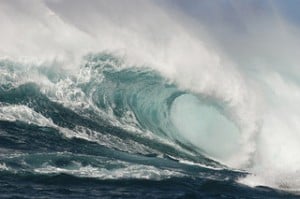
Now that summer has come to a close and everyone is returning to their homes with tales of downing oyster shots and hiking the continental divide, I think it’s appropriate for me to share how I spent my summer vacation. I wasn’t jet skiing in Miami or visiting the coffee houses of northern Europe. I was doing what every good scientist should do is this day and age—climate change tourism. I was visiting a place that won’t be around 100 years from now. And I’ll be honest with you, it was awesome.
Where was this incredible vacation-land? The beaches of North Carolina, of course. North Carolina is rather notorious now for passing legislation that doesn’t allow for the consideration of sea level rise for ocean-side management. Which leads to oodles of lovely beach-front property built high on stilts, for seemingly mysterious reasons…totally unrelated to the ocean….
But sea level was really the least of my worries, as it turns out we decided to stay in the great region of Cape Fear, right next to a Pet Cemetery, spending our days swimming with sharks (we later found out). We might as well have been at a summer camp where a camper had mysteriously disappeared and wandered off by ourselves shouting “I’ll be right back!!”
Of all these fears — hockey masked murderers, zombified cats, ex-cons with an ax to grind – it never occurred to us what we really should have been fearing…sponges. That’s right, ocean sponges.
Now I’m going to blow your mind for a minute here…you know that sponge you use to wash your dishes? Well that synthetic kitchen-helper is based on a real-life organism called…the sponge.
More shocking still, sponges are not plants, as you might think. They are animals. Really, squishy, multi-cellular animals, that can even reproduce….sexually. Weirder still, some of the more unusual varieties are carnivorous—they eat other sea creatures, catching them in their threads and slowly digesting them in some creepy horror movie fashion. Worst of all, those seemingly docile sponges aren’t really docile at all. They’re actually quite the industrialists, destructively excavating into coral reefs — like gophers on a golf course.
But not all sponges are this freaky. Some are quite mellow, getting nutrients by pumping water through their bodies, while others set up delightful symbiotic relationships with little photosynthesizing organisms called dinoflagellates (much like coral do).
The sponges I am going to write about today, Cliona orientalis, fall mid-way into what I would call the sponge creep factor. These animals play host to the photosynthesizing dinoflagellates I mentioned earlier, so you would think they would play well with others, but unfortunately they are also major excavators. Yes, these seemingly immobile animals are little under-sea construction workers drilling into corals and making a bit of a mess.
This ordinarily wouldn’t be such a bit deal. Sponges drill, corals grow back, sponges get eaten by something…corals rejoice. All part of the natural ocean ecosystem. But, of course, because the world is a terrifying place, under “business as usual scenarios” (the Intergovernmental Panel on Climate Change’s term for “you people are so flippin’ lazy, you couldn’t be bothered to reduce your CO2 emissions over the next 100 years”), these excavating sponges grow faster, increasing their bioerosion rates. Yay, for the sponges, bad for the coral.
Now you may be thinking that this is all underwater drama, and as a land creature all you could possibly care about is the opportunity for more potential sponges to buff your lovely little toes with. But of course you must know that coral reefs are important ecosystems for sea animals, including the fish that you and/or your cat probably enjoy, sharks that are always hunting you from shore as you lie on the beach, and well…everyone really. Reefs are important.
So though I started my vacation being full of conventional fears—not having a large enough boat, a zombified version of my cat, Robert Deniro—what I really should have been more afraid of was what was right in front my face the whole time, climate change.
Further Reading:
Sponge biomass and bioerosion rates increase under ocean warming and acidification